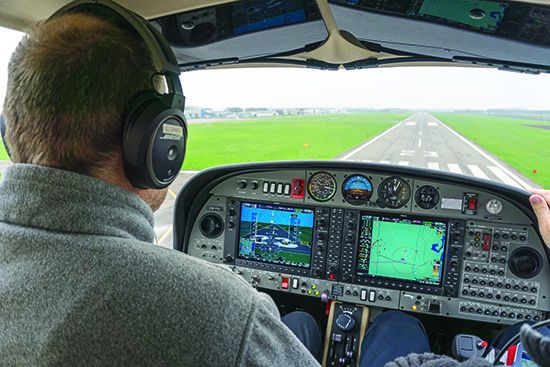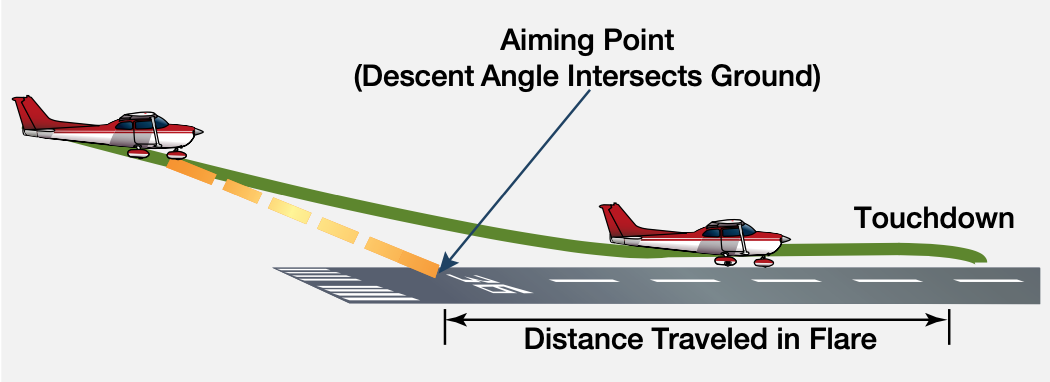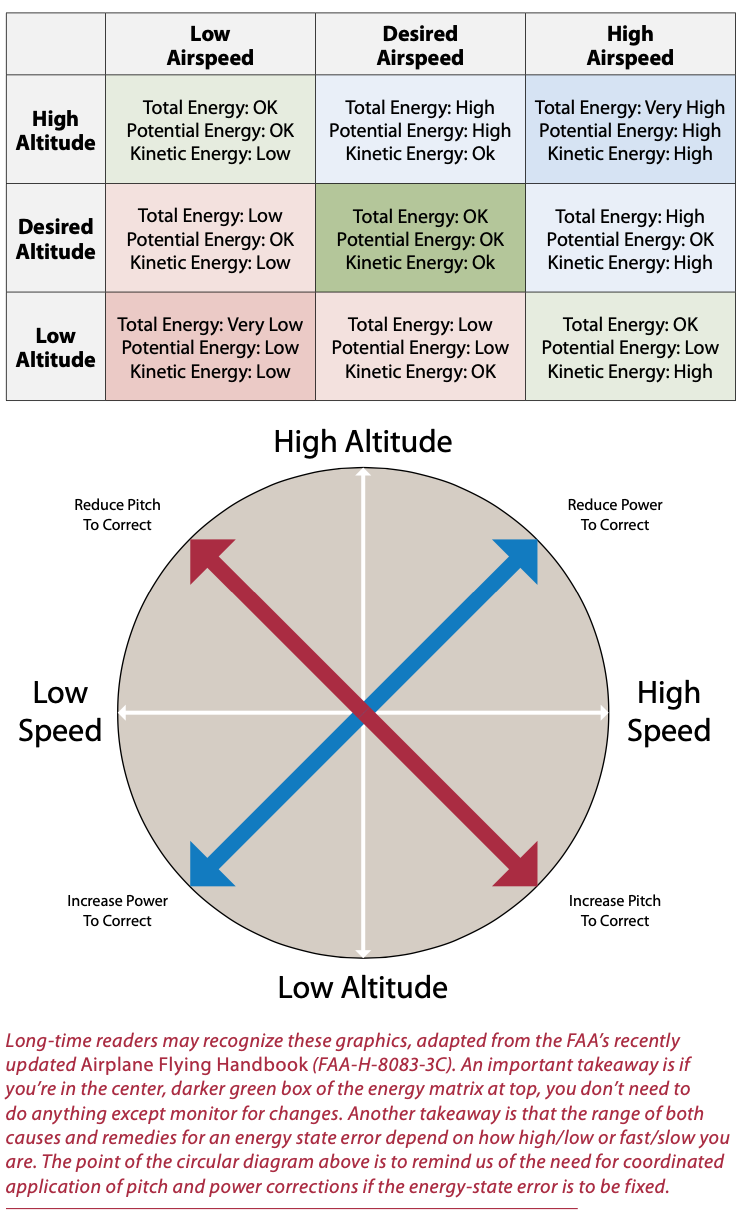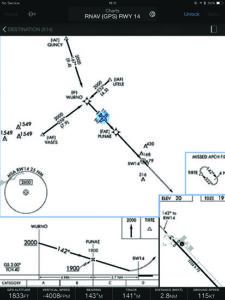
After turning from base to final, a pilot should be able to quickly and correctly determine whether to continue or discontinue the approach to landing by judging salient visual clues. What clues? The runway sight picture, glide path, descent rate, runway heading, airspeed and altitude are the primary ones we should be using. Pilots need to recognize these clues in real time for what they are to gauge the approach’s stability.
A stabilized landing approach, of course, is one in which the pilot establishes and maintains a constant-angle glide path toward a predetermined point on the landing runway. Why is the stabilized landing approach concept so important? In 2000, a task force assembled by the Flight Safety Foundation (FSF), an international nonprofit concerned with aviation safety, “found that unstabilized approaches (i.e., approaches conducted either low/slow or high/fast) were a causal factor in 66 percent of 76 approach-and-landing accidents and serious incidents worldwide in 1984 through 1997.” The FSF’s focus is on commercial operation of turbine-powered transports, so the rate likely is higher among non-commercial operators, like you and me.
The FSF task force also said “that although some low-energy approaches (i.e., low/slow) resulted in loss of aircraft control, most involved CFIT because of inadequate vertical-position awareness” and that “high-energy approaches (i.e., high/fast) resulted in loss of aircraft control, runway overruns and runway excursions, and contributed to inadequate situational awareness in some CFIT accidents.”
FAILURE TO RECOGNIZE
In addition to the FSF task force’s finding, a recently published FAA FAASTeam fact sheet cautioned pilots that “it’s important to recognize high kinetic energy states close-in to airports or near a final approach fix. Similar to descent ratios, the data demonstrates an increased risk potential if speeds during final vectors or approaches are not managed appropriately.”
A likely scenario might go something like this. You’re flying a Cirrus SR22 on a calm, good-weather day with a couple of passengers. Although you’ve got your three bangs-and-goes in the last 90 days, you’re rusty. While maneuvering around the pattern a passenger asks a question and you devote some attention to answering it. Before you know it, there’s the runway threshold, but you’re high and hot, unstabilized.
Rather than go around and face additional questions/doubt from your passengers, you gut it out, pitching down and diving for the runway, which only exacerbates the situation by further increasing the airplane’s already high kinetic energy state. You land long, closer to the runway’s end than the beginning, and have trouble keeping the airplane on the ground; perhaps it’s rocking from side to side or porpoising because you’re too fast. You still haven’t dissipated all the energy you have.
Then you decide it’s time—finally!—to go around. You add full power, but are surprised at the airplane’s reaction. It pitches up abruptly, climbs a couple of hundred feet and stalls. The NTSB’s probable cause statement will include something like “the pilot’s attempt to salvage an unstabilized visual approach, resulting in an aerodynamic stall at low altitude.”

Understanding the stabilized approach concept isn’t that hard: the pilot establishes and maintains a constant-angle glide path toward a predetermined spot on the runway. The problem arises when the approach becomes unstable and we fail to recognize the warning signs and then do something about them, like go around.
When reaching 500 feet agl, the following cockpit tasks already should be accomplished:
- The airplane should be properly configured for landing, i. e., landing flaps set, landing gear deployed (if applicable) and elevator trim set for descent.
- All appropriate briefings and checklists should be accomplished before reaching 500 feet agl on final (or 1000 feet in IMC—see the sidebar on the following page for more).
From 500 feet agl, all the hard work is done. By now you’ve set power as appropriate for the glide and aligned the airplane with the runway’s extended centerline. Between here and the runway, manage the following:
- Airspeed should be as recommended in the POH/AFM for the airplane’s weight, with perhaps a cushion—half the gust value—in situations demanding it.
- The aiming point should remain stationary in the pilot’s vision; it should not move under the nose of the aircraft and should not move forward away from the aircraft until the roundout and flare begin over the runway.
- The descent rate must be proportional to the groundspeed and glide path angle. For the standard three-degree angle of descent glide path at a groundspeed of 90 knots, the descent rate is approximately 500 fpm.
Once below 500 feet agl, any changes in these conditions—erratic airspeed, an aiming point in relative motion or gross failure to maintain heading—should be addressed with a go-around. — J.B.
UNSTABLE CHARACTERISTICS
The best way to recognize unstable approaches is to compare them with stable ones. The sidebar at right hits the highlights (see the sidebar on the following page for additional details on instrument approaches). For example, the SR22 scenario is a small-airplane example of the “high-energy approaches” the FSF highlighted. The opposite scenario—not enough airspeed and/or altitude resulting from low energy—mostly resulted in controlled flight into terrain, or CFIT: coming up short.
Other findings by the FSF task force include what it terms “flight-handling difficulties”—an inability to control the aircraft and place it in the proper position and energy state—were a “causal factor in 45 percent of the 76 approach-and-landing accidents and serious incidents” studied. To no one’s great surprise, adverse conditions like wake turbulence, strong winds, low-level wind shear, low visibility and heavy precipitation increased the chances of an unstabilized approach.
Other factors the FSF task force identified should come as no surprise, either. They include fatigue, schedule pressure, ATC, a late runway change, traffic complications and visual illusions. Crew-induced factors also were present, the task force said. Among the mix were “failure to recognize deviations or failure to adhere to the excessive-parameter-deviation limits” and the “belief that the aircraft will be stabilized at the minimum stabilization height or shortly thereafter.”
Any time similar factors are present in the cockpit, the likelihood of an unstable approach increases. The key here is to recognize the clues.

FINDING YOUR ENERGY STATE
But let’s go back to energy management concepts, as we discussed in the Cirrus scenario. As published in the recently updated Airplane Flying Handbook, they are applicable to flying a stabilized approach to landing. They will be on the test: The FAA’s airman certification standards (ACS) for private and commercial certificates specify that pilots are to have knowledge of energy management concepts for landings and go-arounds. The word “knowledge” implies pilots should have, at least, a basic understanding of the subject and be able to apply those concepts in their operations.
Managing an aircraft’s total energy while on the glide path—balancing airspeed (kinetic energy) and altitude (potential energy)— for landing is required from the beginning of the approach to touchdown. The energy state matrix at top left defines nine possible aircraft energy states, as described in the table. Applying the matrix to an approach to landing is easy: the “desired energy state,” a goal for flying a stabilized approach to landing, for example, is found in the center, darkest-green box in the matrix. We know we’re in this box when potential and kinetic energy states are appropriate.
The bottom left and upper right boxes in the energy state matrix define the most hazardous energy states. The lower left box defines a low-energy, unstabilized approach characterized by very low potential and kinetic energy. It is associated with aerodynamic stalls, losing control and CFIT “coming up short” mishaps due to inadequate vertical position awareness.
The opposite situation is described in the upper right box: a high-energy unstabilized approach. This situation is associated with excessive airspeed while diving for the runway and at touchdown, hard landings, losing control on the ground, landing too far down the runway and runway excursion at the end, possibly leading to injuries and fatalities.
In both cases, the safer solution is to go around and return for another approach. To decide whether or not to initiate a go-around, a pilot first needs to be able to recognize the approach is unstable and admit they have mismanaged the airplane’s total energy.

At the end of the day, the same basic qualities applying to a visual approach’s stability also apply to the instrument version. Energy management remains a key factor, but there’s other stuff related to the procedure itself. According to the Flight Safety Foundation (FSF), here are some highlights:
- Instead of 500 feet, the instrument-approach target by which you should be stabilized is 1000 feet agl.
- All briefings and checklists must be conducted before reaching 1000 feet agl on the approach.
- ILS approaches are to be flown within one dot on both the glideslope and the localizer.
- On a circling approach, the wings must be level when at 300 feet agl on final approach.
- A unique approach or abnormal conditions requiring deviation from stable approach standards require a special briefing. — J.B.
RECOGNITION IS KEY
In other words, any time we recognize that we’re outside normal parameters for an approach and landing, an alarm bell should go off, warning us of the greater risk of a mishap resulting from the unstable maneuver. Regardless of aircraft type, pilot experience level, or whether the flight is conducted in VMC or IMC, a safety-critical pilot skill is to be proficient at recognizing the clues of low- and high-energy unstabilized approaches to landing.
For example, if you’re tired and rushed, trying to make up for a late departure, you should automatically understand that makes you more susceptible to flying an unstable approach. Pilots should train to withstand pressures from ATC and passengers to always land the aircraft on the initial pass at the runway because of the high risks involved in trying to salvage the mess you’ve made.
When flying at 90 knots on the industry-standard three-degree glide path at 500 feet on final approach, you’re descending at about 500 feet per minute. In other words, you’ll be over the runway in another 60 seconds. Is everything lining up as you want (and as stable-approach recommendation include)? You’re on-speed, in a steady-rate descent and aligned with the runway? All airplane configurations tasks and checklists are complete? Traffic’s not a factor?
That last minute, the last 500 feet, gives you a lot of time to decide if the approach is stabilized, and to initiate a go-around if you’re not happy with what you’re seeing. The longer your wait, the less time you have and the closer to the ground you’ll be if “something happens.”
While the airplane’s energy state is just one of the factors determining a stable approach, it’s an important one—perhaps the most important one—and the one carrying with it the greatest likelihood of losing control. Early recognition of the problem and its potential consequences requires assessing the approach before passing through 500 feet on final. If there’s any doubt, go around. Spend the time on downwind coming to grips with what went wrong, and fix it.
Michael J. Banner PhD is a flight instructor at University Air Center, Gainesville (Fla.) Regional Airport (KGNV), courtesy professor at the University of Florida, and a check pilot examiner/instructor pilot in the Civil Air Patrol. A CFII and MEI, he has 6200 hours flight time and owns an American Champion Citabria.




Helpful article thank you. Is there room for a deliberate unstable approach like at those interesting airports that require a non-standard circuit due to their constraints?
Last week I landed at a known tricky airport in Switzerland: I was at 1000ft AGL after turning onto final with less than a minute before passing over the threshold, to respect the minimum height on the base leg. I came diving down with full flaps and no power, 5kts slower than Vfe. The point when I was finally on the correct glide slope was when I was just about to pass the threshold but then I was going 20kts faster than normal. Go around? I knew there was no other way to drop in slower while respecting their base height constraints, and looking down the massively long runway I started gently pulling back to shed speed. The aircraft landed gently about 200m after the normal landing point. Crazy unstable approach, controlled soft landing albeit late.
I asked an instructor later that day if there was a better way to do it and he replied: “you can ignore their base height requirements!” No perfect option for such an airport..